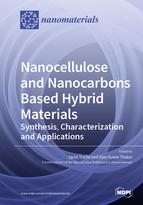Nanocellulose and Nanocarbons Based Hybrid Materials: Synthesis, Characterization and Applications
A special issue of Nanomaterials (ISSN 2079-4991). This special issue belongs to the section "2D and Carbon Nanomaterials".
Deadline for manuscript submissions: closed (31 July 2020) | Viewed by 72114
Special Issue Editors
Interests: bio-based materials; nanocellulose; nanomaterials; characterization; analytical methods; thermal analysis; kinetics; advanced materials; nanoenergetic materials; propellant; energetic materials; multifunctional polymer composites and nanocomposites
Special Issues, Collections and Topics in MDPI journals
2. Enhanced Composites and Structures Center, School of Aerospace, Transport and Manufacturing, Cranfield University, Cranfield MK43 0AL, UK
Interests: biorefining, chemistry, nanotechnology, biomass, and waste; biomedical engineering; composites; sensors; manufacturing of functional materials; aerospace materials; nanomaterials; renewable energy; smart materials; surface engineering; water science and engineering; additive manufacturing of polymers and composites; multifunctional polymer composites and nanocomposites: self-healing, nanoelectronic materials; hydrogels; membranes; nanofiber; composites for extreme environments and manufacturing technology
Special Issues, Collections and Topics in MDPI journals
Special Issue Information
Dear Colleagues,
Since the emergence of nanotechnology in the past few decades, the development and design of hybrid bio- nanomaterials has become an important field of research. Looking at the growing concern about the environment and sustainability, such nanomaterials find many applications in a wide range of domains that influence our society and our way of life. The improvement of properties and the discovery of new functionalities are key goals that cannot be reached without a well-controlled and a better understanding of the preparation, characterization, manufacturing and properties which constitute the starting points of the design of specific and adequate systems. Investigation of nanocellulose/nanocarbons hybrid materials has demonstrated both the academic and technological importance, and offered great research opportunities within cross-disciplinary areas. In our opinion, the applied aspects of such nanomaterials should get proper attention now and bring an interdisciplinary effort to accomplish a more detailed understanding of such hybrid materials.
This Special Issue of Nanomaterials will attempt to publish high quality short communications, research papers covering the most recent advances as well as comprehensive reviews addressing novel and state-of-the-art topics from active researchers in the field of nanocellulose/nanocarbons hybrid materials, concerning, not only the synthesis, preparation and characterization, but especially focusing on the applications of such nanomaterials with outstanding performances. Potential nanocellulose/nanocarbons hybrid materials topics include, but are not limited to:
- Preparation of nanocellulose/nanocarbons hybrid materials with outstanding properties for next-generation applications.
- Characterization of nanocellulose/nanocarbons hybrid materials.
- Nanocellulose/nanocarbons hybrid materials application (medical, filtration, environmental, energy, corrosion, catalysis, automotive, aerospace, sensors, adhesives, packaging, food, construction, other sustainable applications).
Prof. Dr. Djalal Trache
Prof. Dr. Vijay Kumar Thakur
Guest Editors
Manuscript Submission Information
Manuscripts should be submitted online at www.mdpi.com by registering and logging in to this website. Once you are registered, click here to go to the submission form. Manuscripts can be submitted until the deadline. All submissions that pass pre-check are peer-reviewed. Accepted papers will be published continuously in the journal (as soon as accepted) and will be listed together on the special issue website. Research articles, review articles as well as short communications are invited. For planned papers, a title and short abstract (about 100 words) can be sent to the Editorial Office for announcement on this website.
Submitted manuscripts should not have been published previously, nor be under consideration for publication elsewhere (except conference proceedings papers). All manuscripts are thoroughly refereed through a single-blind peer-review process. A guide for authors and other relevant information for submission of manuscripts is available on the Instructions for Authors page. Nanomaterials is an international peer-reviewed open access semimonthly journal published by MDPI.
Please visit the Instructions for Authors page before submitting a manuscript. The Article Processing Charge (APC) for publication in this open access journal is 2900 CHF (Swiss Francs). Submitted papers should be well formatted and use good English. Authors may use MDPI's English editing service prior to publication or during author revisions.
Keywords
- Cellulose nanocrystals
- Cellulose nanofibers
- Bacterial cellulose
- Graphene
- Graphene oxide
- Carbon nanotubes
- Nanodiamond
- hybrid nanomaterials
- Preparation methods
- Properties
- Characterization
- Application








